Improved DRUS 4H-SiC MESFET with High Power Added Efficiency
Abstract
1. Introduction
2. Device Structure and Simulation Method and Fabrication Feasibility
2.1. Device Structure
2.2. Simulation Method
2.3. Fabrication Feasibility
3. Results and Discussion
3.1. The Effect of the Doping Concentration (Nd) and Thickness(H1) of the Upper Layer Region on the Device Parameters
3.2. The Effect of the Doping Concentration (Nd) and Thickness of the Upper Layer Region (H1) on PAE
3.3. Optimization of the Undoped Region Thickness (H2)
3.4. Mechanism to Improve Device Parameters
4. Conclusions
Author Contributions
Funding
Conflicts of Interest
References
- Hjelmgren, H.; Allerstam, F.; Andersson, K. Transient simulation of microwave SiC MESFET with improved trap models. IEEE Trans. Electron. Devices 2012, 57, 729–732. [Google Scholar] [CrossRef]
- Zhang, Y.R.; Zhang, B.; Li, Z.J. Two-dimensional analysis of the interface state effect on current gain for a 4H-SiC bipolar junction transistor. Chin. Phys. B 2010, 19. [Google Scholar] [CrossRef]
- Chen, F.-P.; Zhang, Y.-M.; Zhang, Y.-M.; Lu, H.-L.; Song, Q.-W. Simulation research on offset field-plate used as edge termination in 4H-SiC merged PiN-Schottky diodes. Chin. Phys. B 2010, 19. [Google Scholar] [CrossRef]
- Zhang, X.J.; Yang, Y.T.; Duan, B.X.; Chen, B.; Chai, C.-C.; Song, K. New 4H silicon carbide metal semiconductor field-effect transistor with a buffer layer between the gate and the channel layer. Chin. Phys. B 2012, 21. [Google Scholar] [CrossRef]
- Zhu, C.L.; Zhao, P.; Xia, J.H. Characterization of SiC MESFETs with narrow channel layer. Microelectron. Eng. 2006, 83, 72–74. [Google Scholar]
- Raynaud, C.; Tournier, D.; Morel, H.; Planson, D. Comparison of high voltage and high temperature performances of wide bandgap semiconductors for vertical power devices. Diam. Relat. Mater. 2010, 19, 1–6. [Google Scholar] [CrossRef]
- Dimitrijev, S.; Han, J.; Moghadam, H.A.; Aminbeidokhti, A. Power-switching applications beyond silicon: Status and future prospects of SiC and GaN devices. MRS Bull. 2015, 40, 399–405. [Google Scholar] [CrossRef]
- Jia, H.J.; Wu, Q.Y.; Hu, M. A novel 4H-SiC MESFET with multi-recessed p-buffer layer for high energy-efficiency applications. Superlattices Microstruct. 2017, 112, 97–104. [Google Scholar] [CrossRef]
- Jia, H.; Wu, Q.; Hu, M.; Yang, Z.; Ma, P.; Luo, Y.; Yang, Y. An Improved UU-MESFET with High Power Added Efficiency. Micromachines 2018, 9, 573. [Google Scholar] [CrossRef] [PubMed]
- Zhu, S.; Jia, H.; Wang, X.; Liang, Y.; Tong, Y.; Li, T.; Yang, Y. Improved MRD 4H-SiC MESFET with High Power Added Efficiency. Micromachines 2019, 10, 479. [Google Scholar] [CrossRef] [PubMed]
- Jia, H.; Tong, Y.; Li, T.; Zhu, S.; Liang, Y.; Wang, X.; Zeng, T.; Ynag, Y. An Improved 4H-SiC MESFET with a Partially Low Doped Channel. Micromachines 2019, 10, 555. [Google Scholar] [CrossRef] [PubMed]
- Orouji, A.A.; Aminbeidokhti, A. A novel double-recessed 4H-SiC MESFET with partly undoped space region. Superlattices Microstruct. 2011, 50, 680–690. [Google Scholar] [CrossRef]
- Zhu, C.L.; Rusli; Tin, C.C.; Zhang, G.H.; Yoon, S.F.; Ahn, J. Improved performance of SiC MESFETs using double-recessed structure. Microelectron. Eng. 2006, 83, 92–95. [Google Scholar] [CrossRef]
- Sze, S.M.; Ng, K.K. Physics of Semiconductor Devices, 3rd ed.; John Wiley & Sons: Hoboken, NJ, USA, 2007; pp. 303–304, 386–398. [Google Scholar]
- Weitzel, C.E.; Palmour, J.W.; Carter, C.H. 4H-SiC MESFET with 2.8 W/mm power density at 1.8 GHz. IEEE Electron. Device Lett. 1994, 15, 406–408. [Google Scholar] [CrossRef]
- Andersson, K.; Sudow, M.; Nilsson, P.A. Fabrication and characterization of field-plated buried-gate SiC MESFETs. IEEE Electron. Device Lett. 2006, 27, 573–575. [Google Scholar] [CrossRef]
- Razavi, S.M.; Zahiri, S.H.; Hosseini, S.E. A novel 4H–SiC MESFET with recessed gate and channel. Superlattices Microstruct. 2013, 60, 516–523. [Google Scholar] [CrossRef]
- Lee, T.H. The Design of CMOS Radio-Frequency Integrated Circuits; Cambridge University Press: Cambridge, UK, 1998. [Google Scholar]
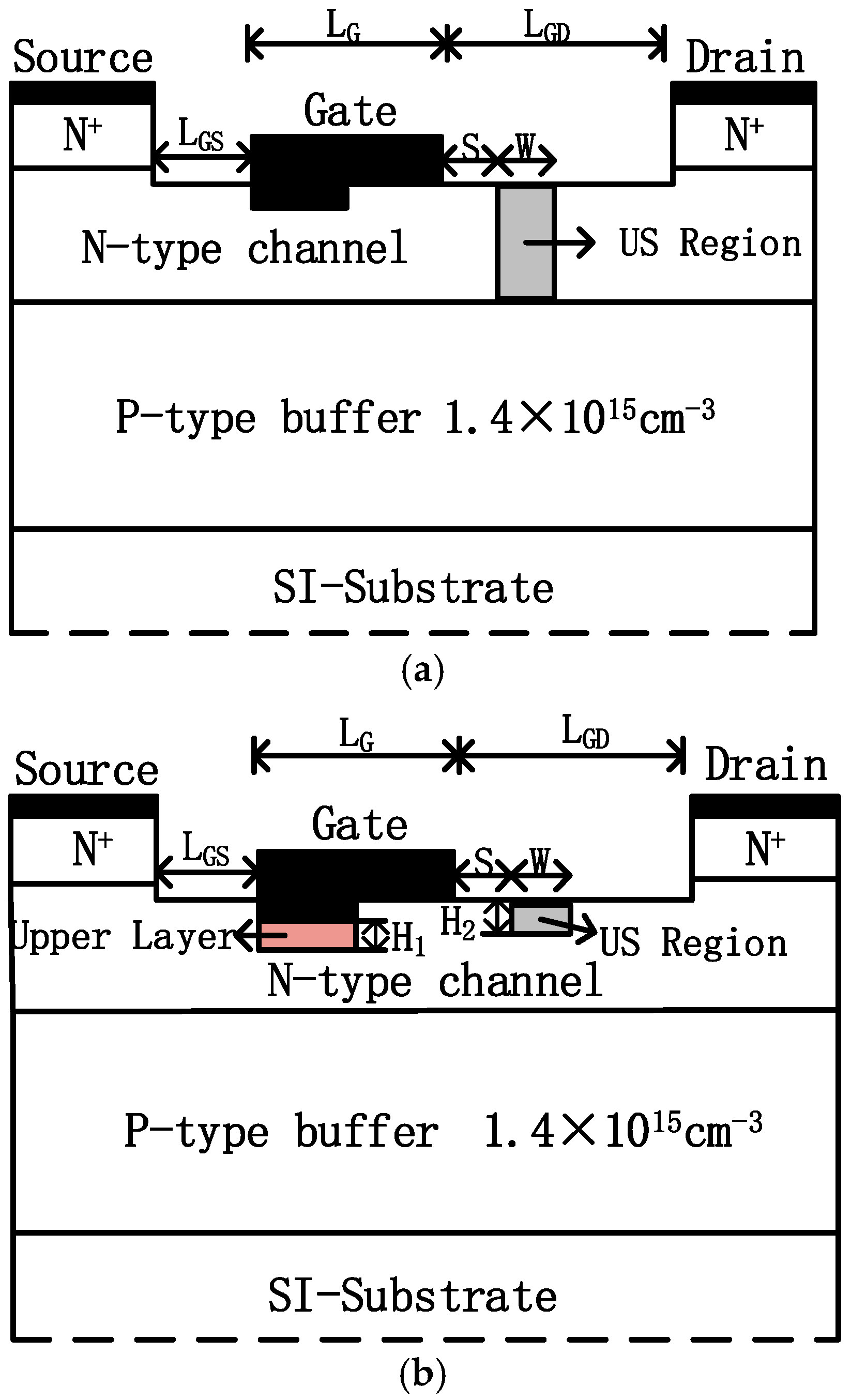
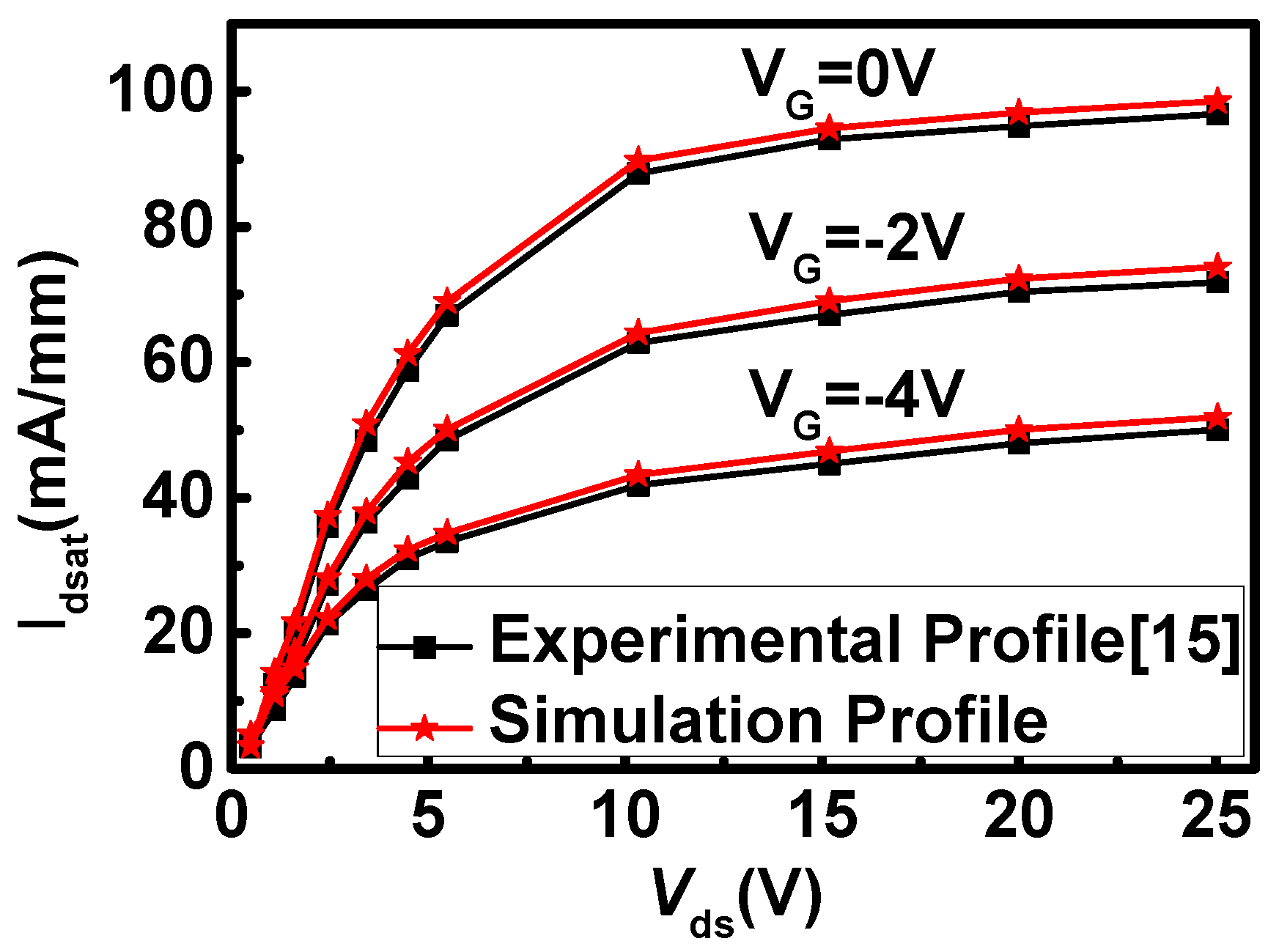
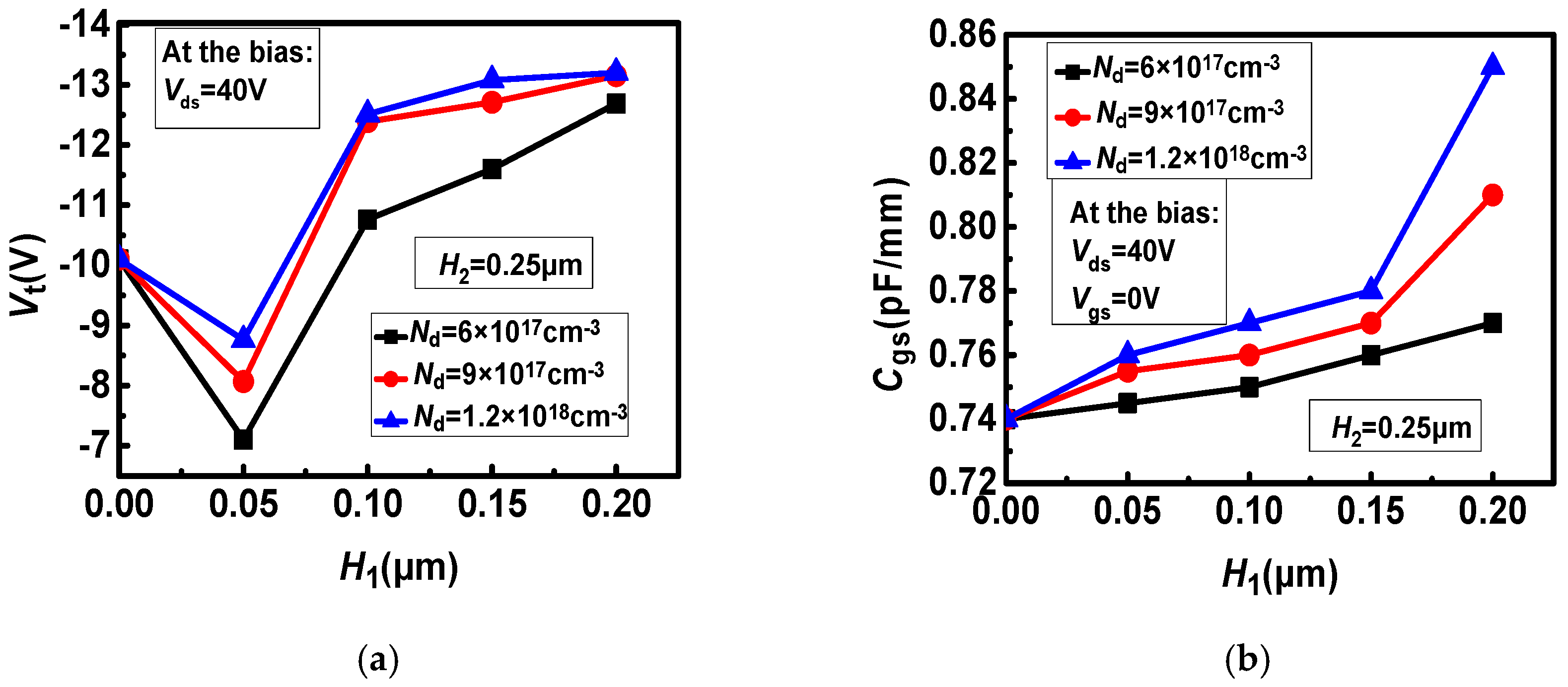
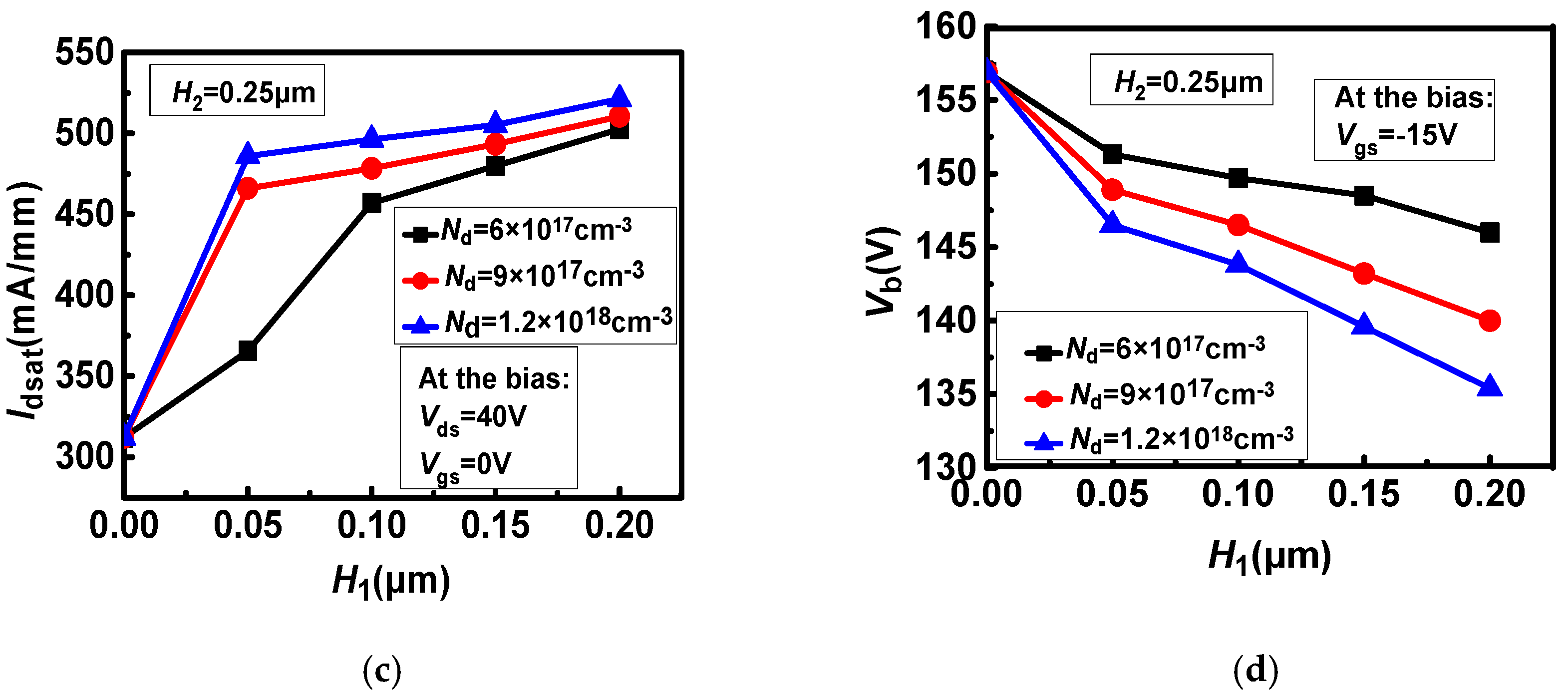
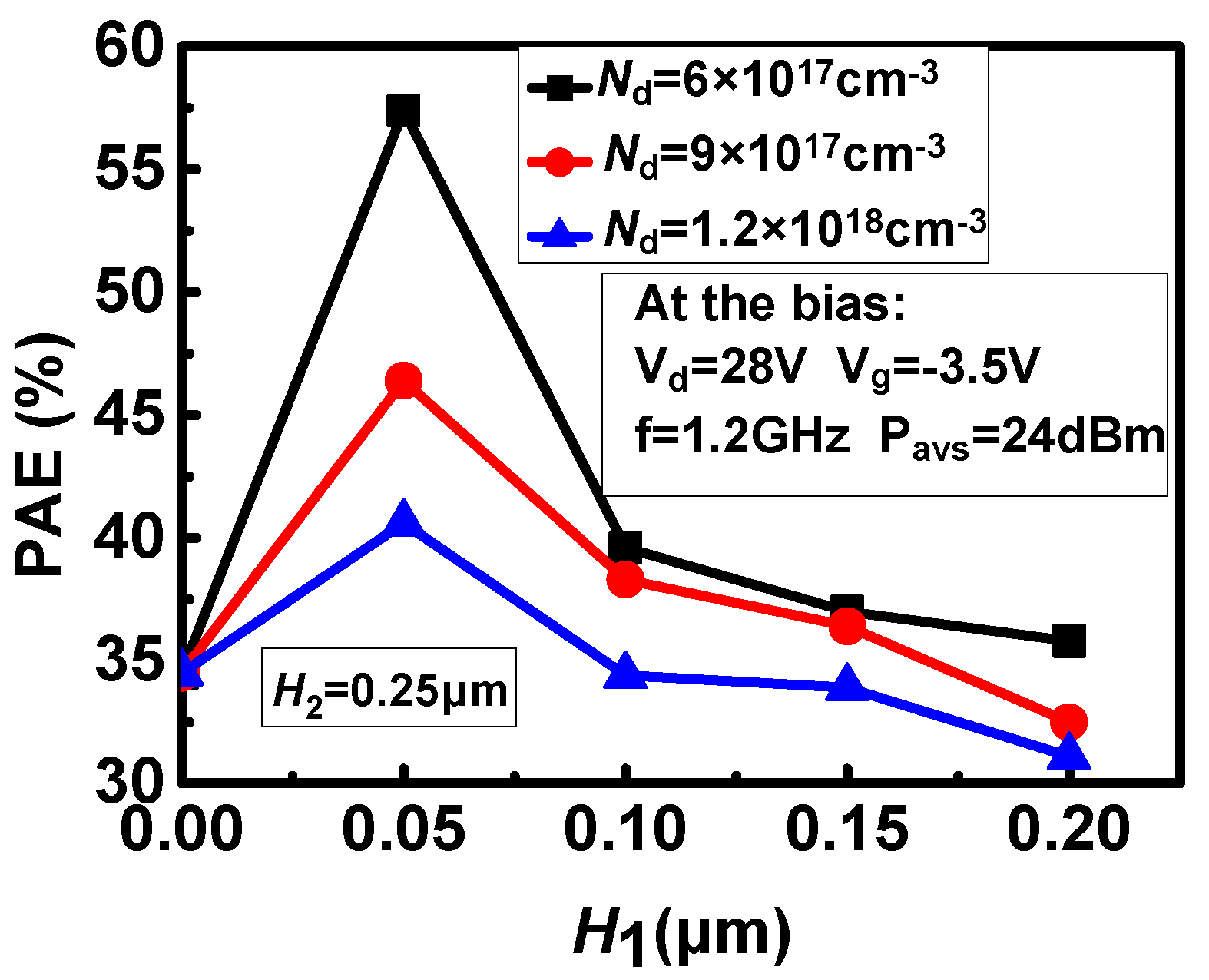
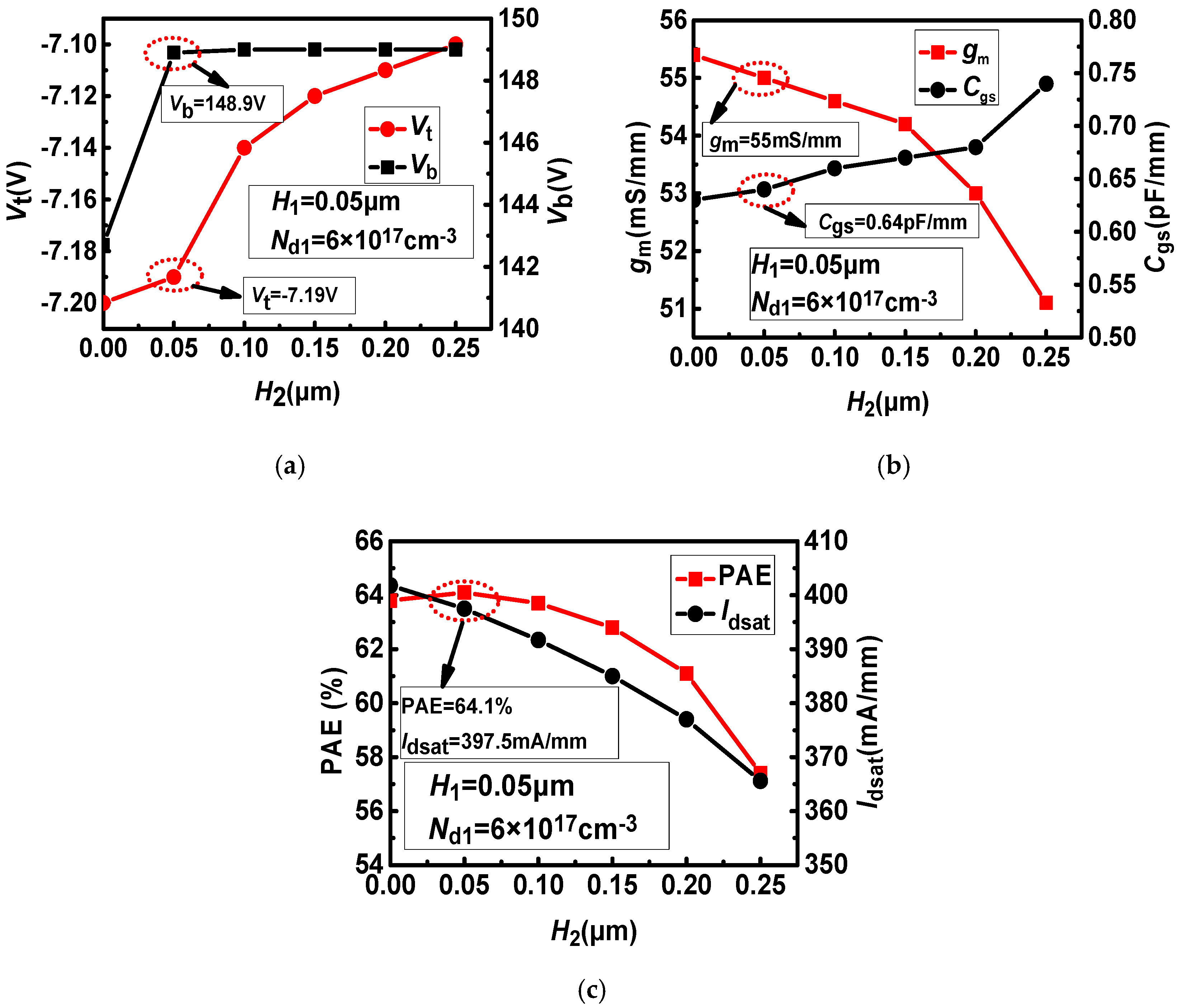
| Parameters | Values |
|---|---|
| P-Buffer Concentration | 1.4 × 1015 cm−3 |
| N-Channel Concentration | 3 × 1017 cm−3 |
| N-Cap layers Concentration | 2 × 1019 cm−3 |
| Upper layer Concentration | 6 × 1017 cm−3 |
| N-Cap layers Thickness | 0.2 μm |
| N-Channel Thickness | 0.25 μm |
| P-Buffer Thickness | 0.5 μm |
| Recess gate Thickness | 0.05 μm |
| Recess gate Width | 0.35 μm |
| W | 0.3 μm |
| S | 0.2 μm |
| Lgs | 0.5 μm |
| Lgd | 1.0 μm |
| Ls | 0.5 μm |
| Ld | 0.5 μm |
| Lg | 0.7 μm |
| H1 | 0.05 μm |
| H2 | 0.05 μm |
| Parameters | DRUS-MESFET | LDUS-MESFET |
|---|---|---|
| Idsat (mA/mm) | 312 | 397.5 |
| Vb (V) | 156.9 | 148.9 |
| gm (mS/mm) | 43.8 | 55 |
| Vt (V) | −10.1 | −7.19 |
| Cgs (pF/mm) | 0.74 | 0.64 |
| PAE (%) | 34.5 | 64.1 |
© 2019 by the authors. Licensee MDPI, Basel, Switzerland. This article is an open access article distributed under the terms and conditions of the Creative Commons Attribution (CC BY) license (http://creativecommons.org/licenses/by/4.0/).
Share and Cite
Jia, H.; Liang, Y.; Li, T.; Tong, Y.; Zhu, S.; Wang, X.; Zeng, T.; Yang, Y. Improved DRUS 4H-SiC MESFET with High Power Added Efficiency. Micromachines 2020, 11, 35. https://doi.org/10.3390/mi11010035
Jia H, Liang Y, Li T, Tong Y, Zhu S, Wang X, Zeng T, Yang Y. Improved DRUS 4H-SiC MESFET with High Power Added Efficiency. Micromachines. 2020; 11(1):35. https://doi.org/10.3390/mi11010035
Chicago/Turabian StyleJia, Hujun, Yuan Liang, Tao Li, Yibo Tong, Shunwei Zhu, Xingyu Wang, Tonghui Zeng, and Yintang Yang. 2020. "Improved DRUS 4H-SiC MESFET with High Power Added Efficiency" Micromachines 11, no. 1: 35. https://doi.org/10.3390/mi11010035
APA StyleJia, H., Liang, Y., Li, T., Tong, Y., Zhu, S., Wang, X., Zeng, T., & Yang, Y. (2020). Improved DRUS 4H-SiC MESFET with High Power Added Efficiency. Micromachines, 11(1), 35. https://doi.org/10.3390/mi11010035






